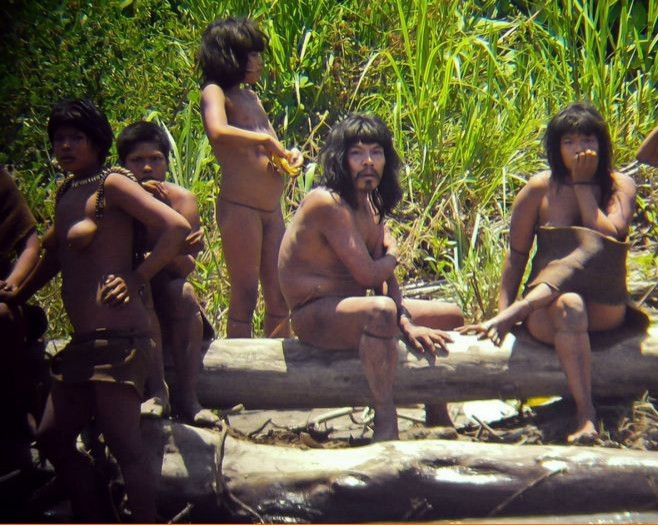Who are the Mashco-Piro? Rare Glimpse of ‘Uncontacted’ Tribe Captured for the First Time [PHOTOS]

Photo Credit:www.survivalinternational.com. Rare picture of the Mashco-Piro tribe that is said to be one of 100 uncontacted tribes said to exist around the world.
Rare photographs of an indigenous Peruvian tribe were made public online by Survival International, apparently the only non-profit organization working for tribal people's rights worldwide.
Sadly, there is very little that the world knows about the Peruvian tribe and several other isolated and endangered communities kept away from any contact with the modern world.
In fact, the government and politicians are the major violators of their rights.
A noteworthy write-up by David Hill on The Ecologist throws light on the insights of their background, troubles and life of the tribe.
Those images are of an isolated nomadic group that has never been in any regular contact with outside world. However, there are evidence that their forefathers had contacts in the past.
These uncontacted people, called as Mashco-Piro by the anthropologists and locals, are inhibited the same place ever since their origin, some 10,000 years ago.
However, many still doubt their existence because of their cloistered nature. Estimates have proved traces of more than 600 people existing in the area. Some are said to have displaced yet the majority still lives in the Amazon rainforest of South Africa.
It was apparently the most detailed sightings of uncontacted Indians ever recorded on camera.
The photographs were taken by Spanish archeologist Diego Cortijo in the Manu region in the south-east part of Peru with a purpose to highlight the ever growing danger for uncontacted tribes from logging and oil and gas exploration.
Photo Credit: www.survivorinternational.com. The Mashco-Piro tribe hunts using arrows made with bamboo points.
The images were shot in mid-November and just six-days later a local Matsiguenka Indian, Nicolas Shaco Flores, who worked closely with the tribe and guided the photographer, was shot dead with a bamboo-tipped arrow by a member of Mashco-Piro.
In the last decade the encroachments and encounters with these tribes have rapidly increased forcing them to become itinerant, feral and dangerous. Almost half the population has been wiped out due to constant invasion.
This tragic incident underscores the hazards of forcing contact on people who have so adamantly expressed their desire to be left alone, The Ecologist quoted Flores old friend Glenn Shepard as saying.
According to the anthropologists, earlier they were a settled community and practiced agriculture in the rainforest area, but now that most of the land is invaded, they feel threatened and thus are forced to engage in destructive activities for survival.
The Mashco abandonment of agriculture is a 20th century phenomenon, Anthropologist Peter Gow stated in a document on Mashco-Piro community. Only maturing secondary forest contains enough appropriate vegetation to sustain hunter-gatherers. All accounts place the Mashco in such old regenerated forest, whether on the Manu or on the Purus and Piedras.
The Mashco-Piro are said to be the fifteen local groups inhabited near the Peruviand and Brazilian border, on the banks of Las Piedras River.
The dreadful exploitation stories of these indigenous tribes dates back to 19th century when a large number of people during the rubber boom invaded their lands, exploited them and even killed thousands.
Photo Credit: www.survivorinternational.com. Young Mashco-Piro men stand on a riverbank.
Tourists, evangelists, Christian missionaries and several oil companies also gambled and explored their territory of Amazon region in late 19th century and made survival for the remaining members difficult.
The trepidation is that the community needs to be preserved and protected despite their desire to be left alone, but apparently the voice of these vulnerable tribes has fallen to deaf ears.
Mashco-Piro should be left alone and people must never attempt to enter into contact with these communities who are trying to remain apart from the outside world, Mariela Huacchillo, a member of Peru's National Protected Areas department, noted.
Photo Credit: www.survivorinternational.com. Aerial photo of an uncontacted tribe in Brazil, close to the border of Peru.
© Copyright IBTimes 2024. All rights reserved.





















